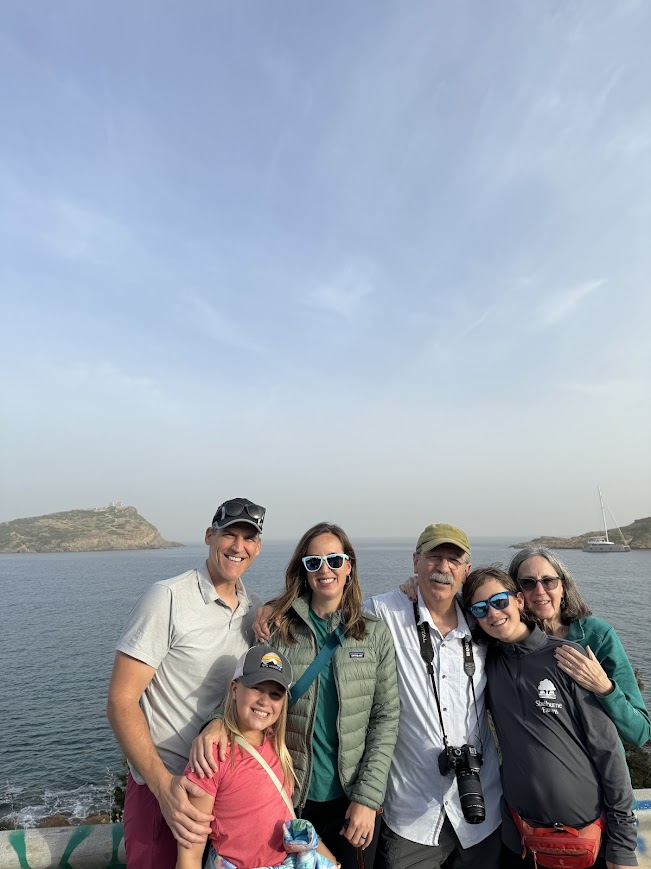Selcouth Chronicles Week 16
Hello family and friends! Welcome to week 16 of the Selcouth Chronicles.
Week 16: April 21 - April 27
April 21 🚗Athens -> Delphi -> Athens
April 25 🚂Athens -> Thessaloniki🚗-> Nea MoudaniaThe Parthenon
GREECE
Highlights: Archaeological Site of Delphi, Lycabettus Hill, Temple of Zeus the Olympian, Kerameikos, Acropolis Hill and Slopes, Temple of Poseidon, Ikos Resort
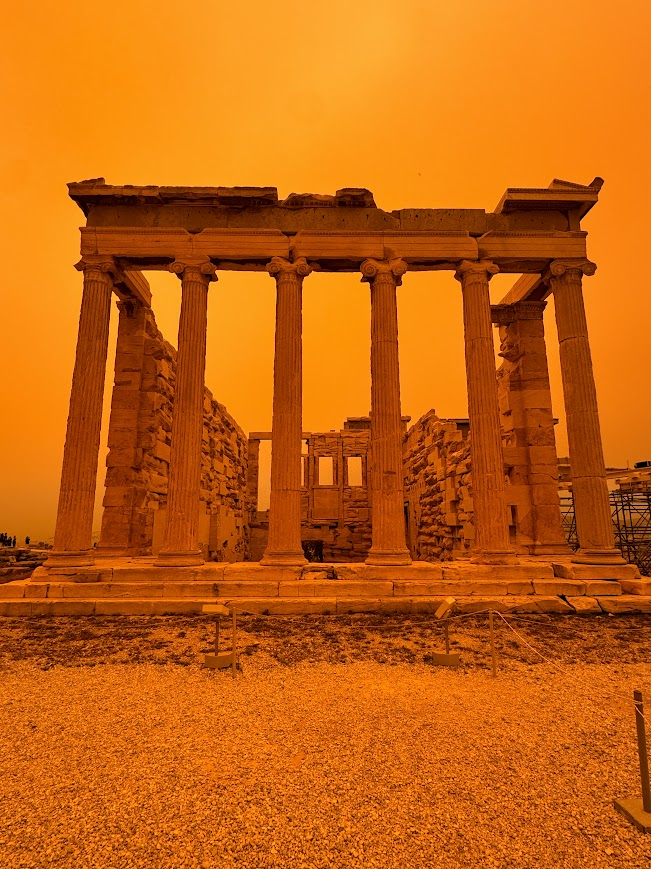
Caitlin:
(*Apologies in advance for the lengthy recap. It was a week of fascinating history and even my best efforts to condense things ran long!)
This week started with a day trip from Athens to Delphi. There aren’t a lot of rental cars in the middle of Athens that can fit six people, especially when you don’t finalize your plans until the day before your departure. Luckily, we happened to be staying in close proximity to a row of rental car storefronts near the downtown area, so Sean and I were able to venture out at 8:30pm on Saturday night and walk from vendor to vendor to find a vehicle for Sunday. We ended up with something closer to a small bus than a car. Sean volunteered to be the adult who took on the challenge of driving this (manual, not automatic!) monstrosity through the winding mountain roads of Greece and returned with a few new gray hairs for his heroism. Parking was absurdly tight in this popular destination and we ended up settling in a ways down the road to prevent Sean from giving himself a stroke trying to parallel park.
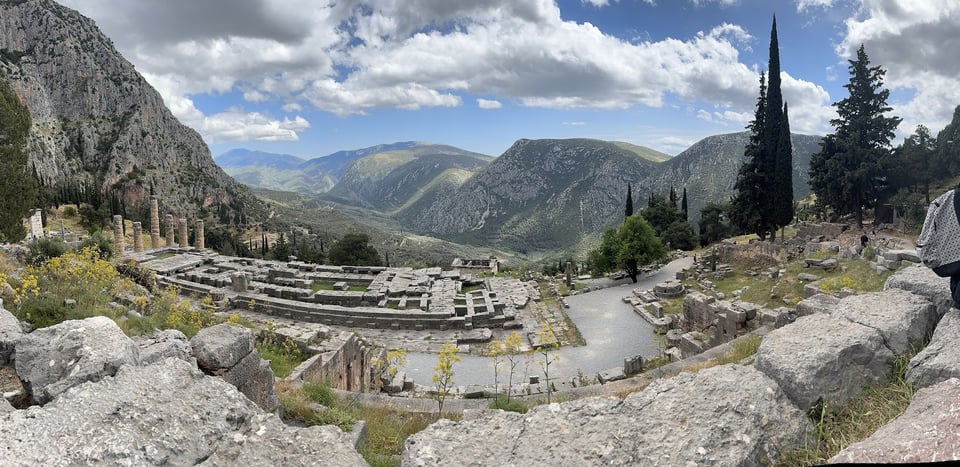
Despite that, we enjoyed the beautiful views along the mountainsides and admired the cute towns of Delphi and Arachova, which looked like charming places to visit if you had a normal-size car to navigate along the narrow roads. The Delphi Archaeological site was a wonder. We had heard a lot about the site through our shared family interest in Greek mythology. According to the ancient Greeks, the location is conducive to other-worldly powers, and the Oracle of Delphi was stationed there where she could communicate with spirits and divine the future. Later, Zeus was said to have released two eagles flying in opposite directions, and the spot where they met in Delphi was the center of the world. It was a fascinating and beautiful site!
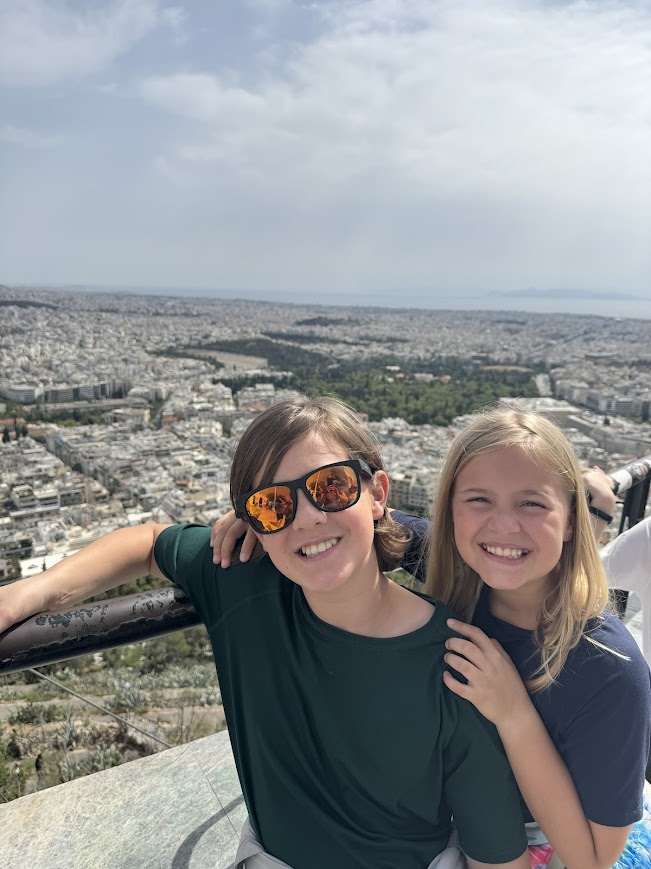
On Monday, Sean crammed in extra work in order to lighten his load at the end of the week. The rest of us ventured up Lycabettus Hill, which is the highest point in Athens and offers 360° views of the surrounding city. We were excited to try riding the funicular on the way up, firstly because it would save Dad’s recently replaced knee from the stress of climbing a large hill, and secondly because we anticipated lovely views on the way up. As it turns out, we were wrong on both counts. The walk through the surrounding neighborhood to reach the funicular was several blocks of steep stairs. Hills are unavoidable in Athens! The ascending view, as it turns out, is of the interior of the funicular tunnel. Luckily, we had a good laugh at our dashed hopes, Dad handled the stairs like a champ, and the views at the top of the hill were impressive enough to merit a nice rest to take it all in.
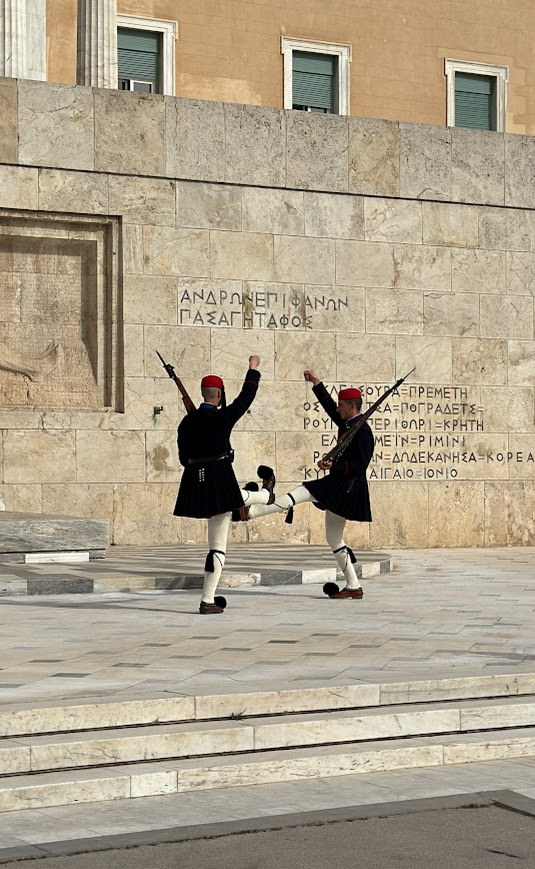
Our return journey through the city was broken up with several stops. First we happened upon the changing of the guard at the Parliament House, which is an absurdly slow ritual that reminds me of horses doing dressage, but just like their equine counterparts the soldiers show incredible strength as they execute their tightly controlled maneuvers. Next we admired Hadrian’s Gate, which was built in honor of Emperor Hadrian and divided the old city (the city of Theseus) and the new city (built by the Roman Empire). “New,” of course, being a relative term because the gate was built circa 132 CE. However, by far the most impressive thing we saw that day was the Olympieion, or Temple of Olympian Zeus. Construction began in 174 BCE under Antichios, the King of Syria. When the king died, the building efforts were abandoned for several hundred years, until being restarted by Hadrian (of the Gate) and finally completed in 131 CE. It has been amazing to visit countries like this, whose histories are so ancient that buildings can be abandoned for hundreds of years and restored, and even the restorations are ancient history! The temple is also amazing for its sheer size: the columns are over 17 meters tall, and more than a meter and a half wide. It’s simply massive and a testament to the engineering skills present in Ancient Greece.
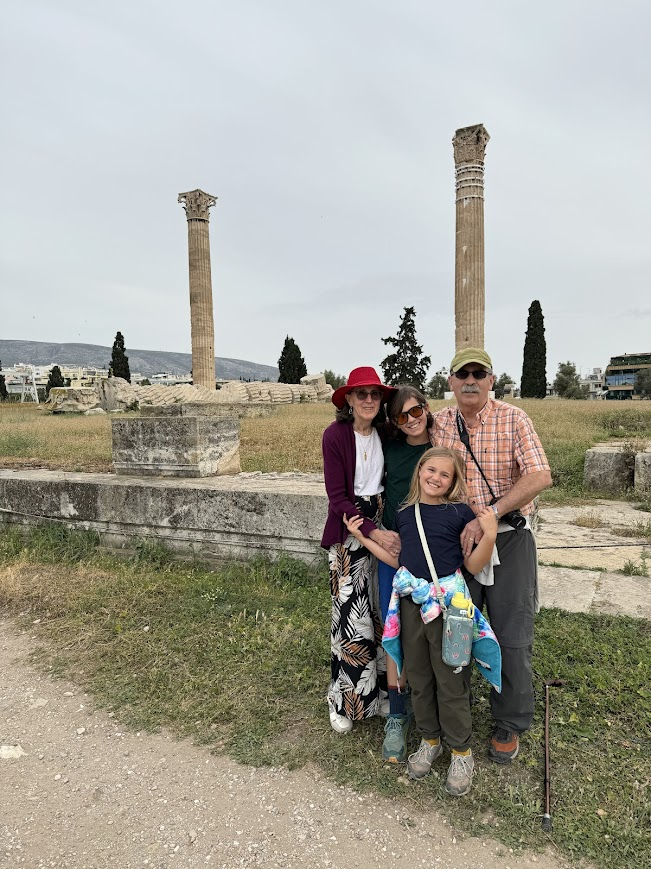
On Tuesday the whole family went to the Kerameikos Archaeological Site and Museum. Kerameikos was named for the potters and artisans who inhabited that part of Athens thousands of years ago (the Latin name is Ceramicus), but its location outside of a nearby flood zone made it a popular place for burials, and the remains of the necropolis tombs and monuments have been under excavation since the late 1800s. It was also the site of the ancient city wall, hastily built under Themistocles as a protective measure after Athens was sacked by the Persians in 480 BCE. It contains the ancient Dipylon Gate, once the main gate to Athens and starting point of the Panathenaic Procession.
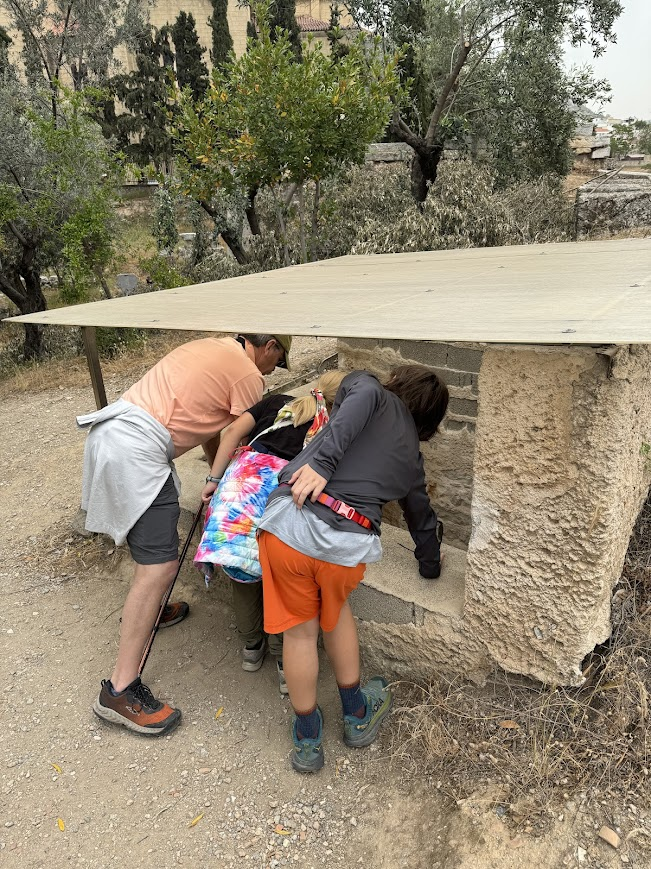
However, our main event on Tuesday was our tour of the Acropolis and slopes, which we had scheduled in the evening to avoid both the main heat of the day and most of the crowds. We decided to hire a private guide for the visit, as there is so much to see in this small area that we anticipated needing a little help absorbing all the history. The Parthenon is the big-ticket item at the Acropolis, but the slopes leading up to it are full of fascinating sites. We saw the Theater of Dionysus (the first theater in the world), and the Odeon of Herod Atticus, which is an additional amphitheater so well-preserved and restored that it is still used for al fresco performances in summers. The site contains The Sanctuary of Asklepios, god of medicine, various temples dedicated to the many iterations (hypostases) of Athena (Athena Parthenos, Athena Nike, Athena Polis), temples to Poseidon and Zeus, and of course the majestic Parthenon.
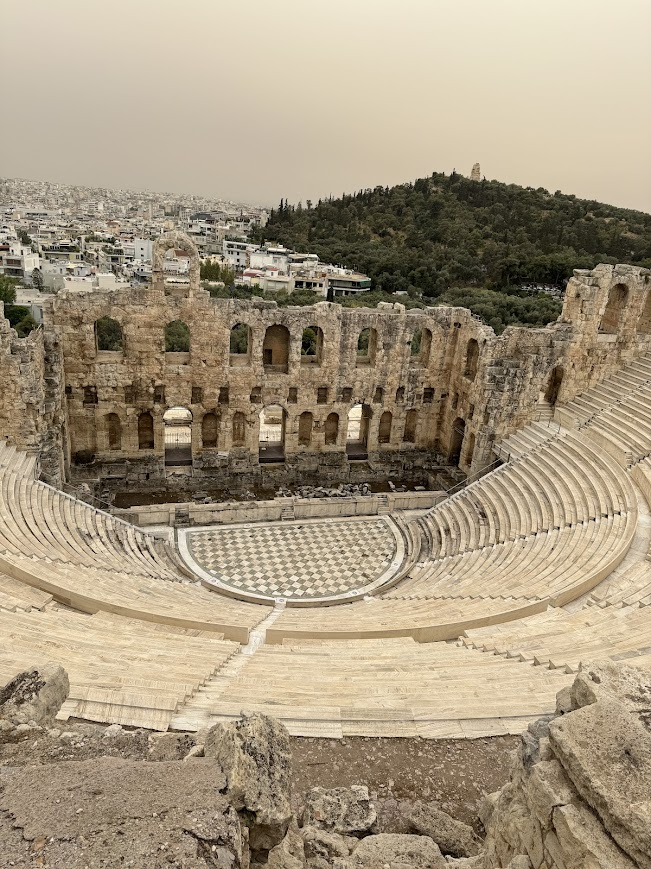
As we ascended the steps, an orange cloud gathered on the horizon and soon overtook the entire city. We later learned that it was dust and sand blown in all the way from the Sahara Desert, but at the time all we knew was that it made for very atmospheric views from the top of the hill. We capped off the evening with a quick hop across the street to Areopagus Hill. There are several Greek Myths around the hill, the end result being that for many years the hill was used for murder trials in Athens. The spot is also known by Christians as the site where the Apostle Paul delivered a sermon which (though generally not well received) converted the first Greeks to Christianity, which eventually became, and remains, the dominant religion of the country. Apart from our appreciation of its history, our main goal in making the stop was to enjoy the fantastic views from this elevated spot next to the Acropolis. It was a great way to end a busy day.
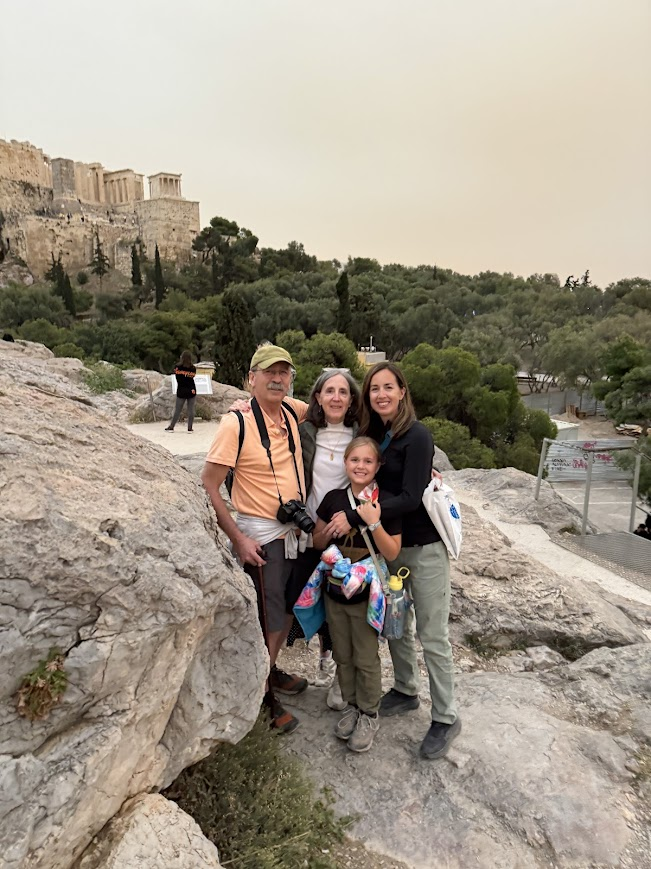
We opted for a slow morning on Wednesday, catching up on laundry and getting repacked for our departure on Thursday. In the afternoon we took a short trip from Athens to the Temple of Poseidon. It was a small group tour; on the way we stopped at Lake Vouliagmeni and had an hour at a beach not too far from the temple. Our guide included some fun tidbits about the area, like the fact that there is an archaeological law in Athens preventing construction of any buildings that block the view of the Acropolis – hence no skyscrapers in the city. As we neared the location of the temple in Cape Sounion, it was easy to see the geographical significance of the site, sitting proudly upon a high bluff overlooking the Aegean Sea. The temple was constructed from 444-440 BCE, built on the ruins of a previous temple dating from the Archaic period. The Ancient Greeks, we have learned, were master recyclers. As Poseidon was one of the most revered gods of the region, given the importance of the sea for trade and protection, the temple was built with the finest materials and was likely frequented by the aristocracy of that time. We chose our tour time to coincide with sunset, and though overcast skies prevented the dramatic light we had hoped for, it was nonetheless a beautiful time of day and we enjoyed watching the sun descending behind the temple.
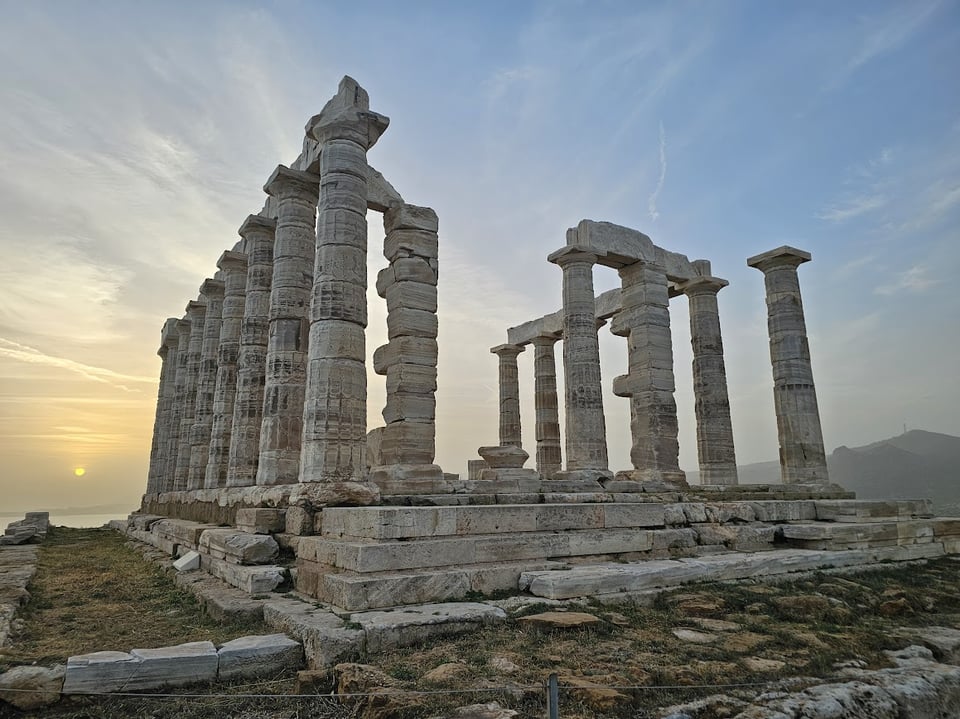
Thursday was the beginning of a very special portion of our trip. When Sean turned 40 two years ago, he had his heart set on celebrating at a particular resort in Greece, a plan which was foiled by the ongoing pandemic. When we were making plans to start our current trip, we decided to add in a belated birthday stop for Sean, and we've all been looking forward to a week of relaxation! We booked a train from Athens to Thessaloniki, the second-largest city in the country and the nearest transportation hub to the resort. After being picked up from the train station, we were driven the final hour to the Ikos Resort, and even after two years of anticipation the location has lived up to our expectations. It’s located on the Aegean Sea with stunning views of Mount Olympus across the water. We arrived shortly before dinner, and afterwards Abby and I retreated to our room so that she could video chat with her class at home and I could have a quick chat with one of the kindergarten classes. Everyone else was able to enjoy a sunset walk along the beach, and later Sean and I ventured out (By ourselves! Late at night!) to one of the hotel bars for a nightcap.
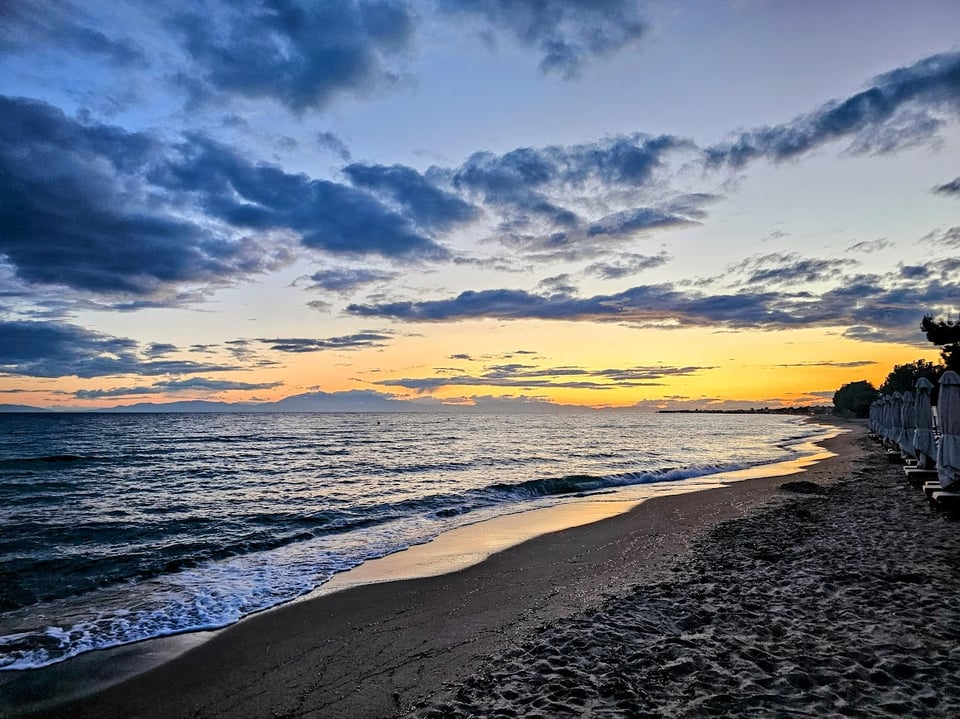
The day started bright and early Friday morning with exercise for the adults. All of the adults except me. Sean began the day with a run into the nearby town, and my parents, as always, were diligent about getting in a quick workout before breakfast. My day looked like this: eating, sitting by the pool, more eating, trip planning, and then dinner. As much as I am loving our trip, the constant mental stress of having to learn about new places, distill down the points of interest most educational and fun for our family, decide on a schedule, and find places to eat, does get to be tiring. We hardly ever have days that I haven’t spent a significant amount of time planning, so I very much enjoyed the hours in the Greek sunshine enjoying a spectacular view and delicious food. Sean has been waiting for this week to take more time off, and it’s so nice to see him able to unplug and enjoy himself without any late-night meetings lurking in the background of his day.
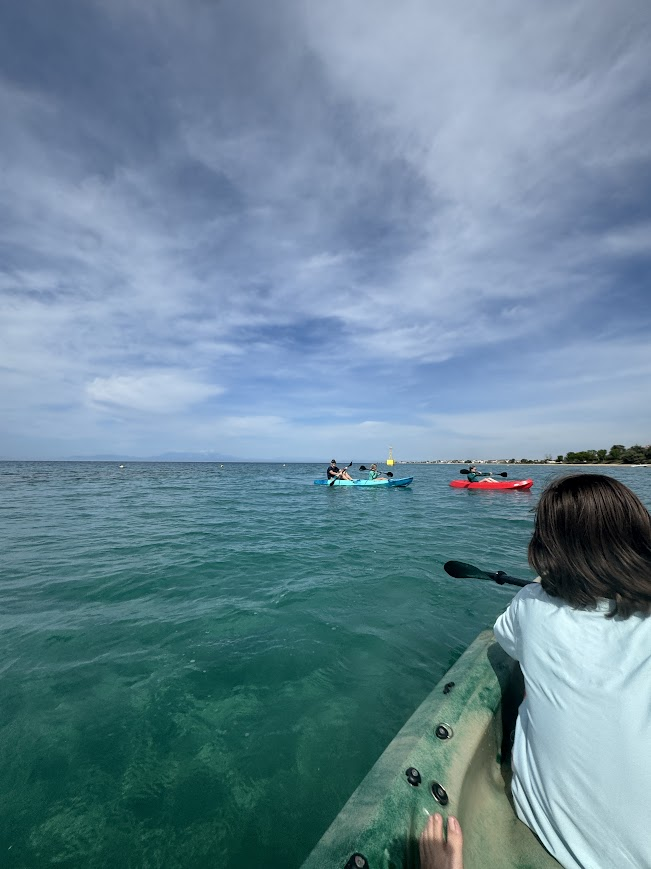
By Saturday I thought I was ready to be more active, but I confess that I didn’t get very far. Things started off strong in the morning, when after breakfast the whole family went down to the beach to make use of the resort’s kayaks. It felt great to be on the water, and the kids had fun refreshing the kayaking skills they learned in Vietnam. We later switched to paddle boats, which came equipped with slides, and Abby and James were delighted to use to them splash into the shallow water. Afterwards some of us attended a Flow Stretching class, which was much needed after months of hikes and carrying heavy bags. We lost some steam in the afternoon, when we made good use of the spa facilities. Mom, Abby and I had pedicures, and Sean got a massage. Dinners here can be late affairs, so after showers we gathered on one of the patios to enjoy a cocktail hour, which even my dad and the kids were able to enjoy thanks to an extensive mocktail menu. We capped off the evening with dinner at the Italian restaurant here, with a menu designed by a Michelin star chef from Athens. The food has been amazing, but we are all particular fans of Italian cuisine and this was our favorite meal yet. The resort has proved itself to be an experience worth waiting for!
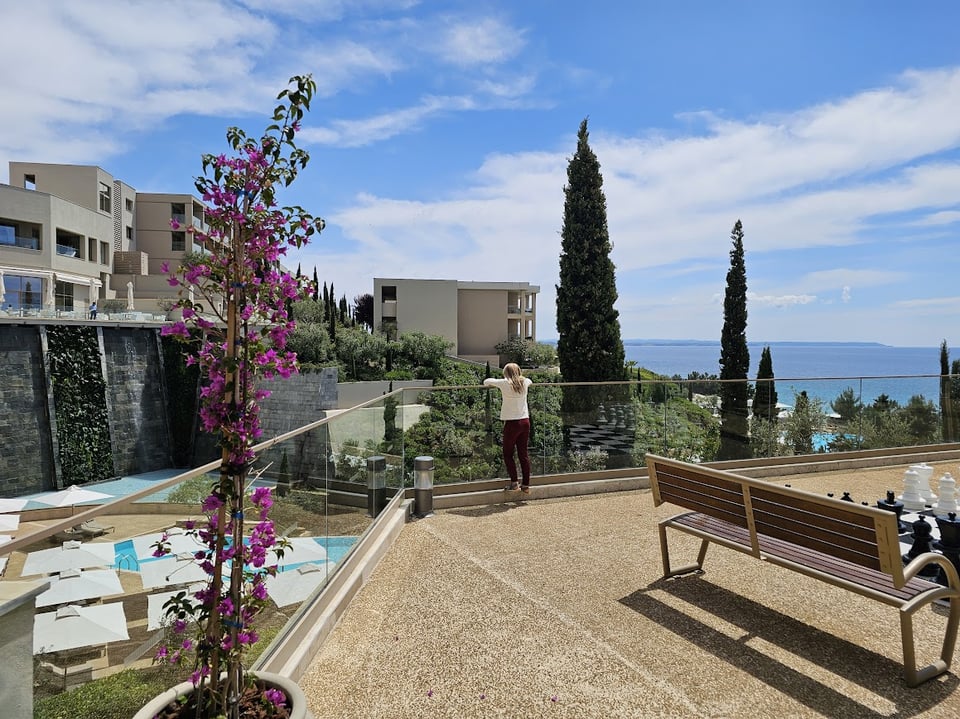
Sean:
One of the things I was most looking forward to when coming to Greece was witnessing the history that is woven into so much of our lives. The stories of the Greek gods and their escapades are told and retold so often that it’s impossible not to connect with them in some form. One figure, and place, that is in almost every story is the Oracle of Delphi, and Delphi was where we went to start this week.
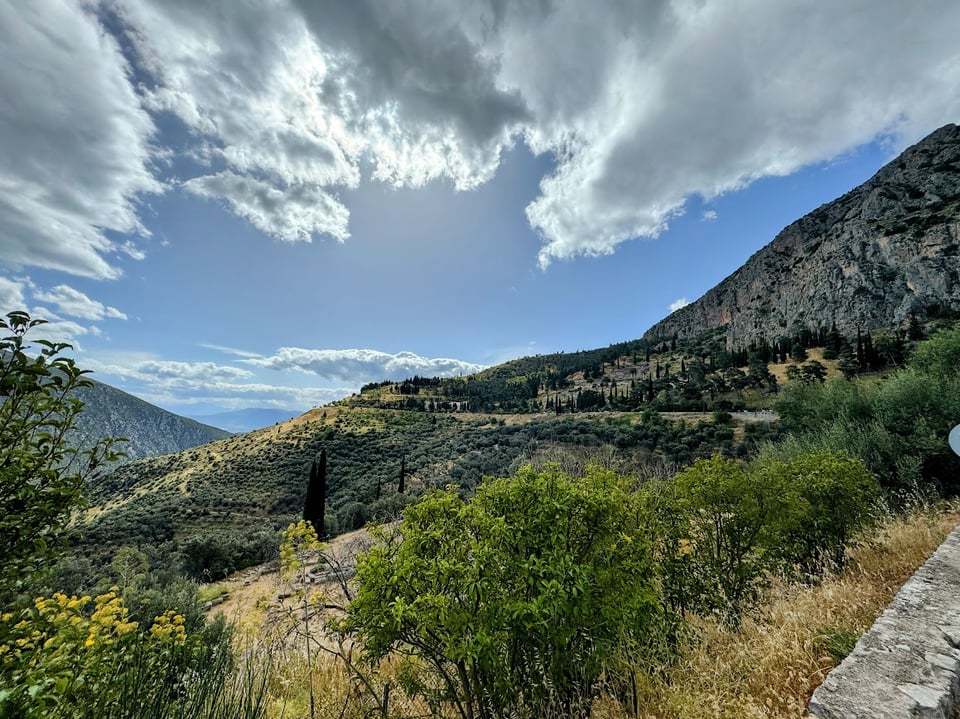
I’m sure everyone reading this knows about the Oracle, but allow me a few sentences to set the stage: Gaia, Mother Earth in Greek mythology, had a location that was full of mystical energy and allowed one to connect with the godly powers. Gaia convinced a Nymph to give oracles from this location, and Gaia worked with her to decode the prophecies and pass them to the visitors. (Note that an Oracle can give oracles from an oracle, so context is required to know which is being discussed.) Gaia also protected the site with her daughter, a giant snake. Through normal jealousy and Greek god shenanigans, Apollo goes to the site and kills the snake. Gaia is so upset, she leaves Delphi, and Apollo takes up ownership. Being a Greek god, he decides it should be less open to the public, and establishes a convoluted setup of how visitors will receive a prophecy, how it’s delivered (much less straightforward), and who should get it. This led to the Oracle as we know it today, with priestesses that translate the prophecies to the visitors and leave a lot to interpretation.
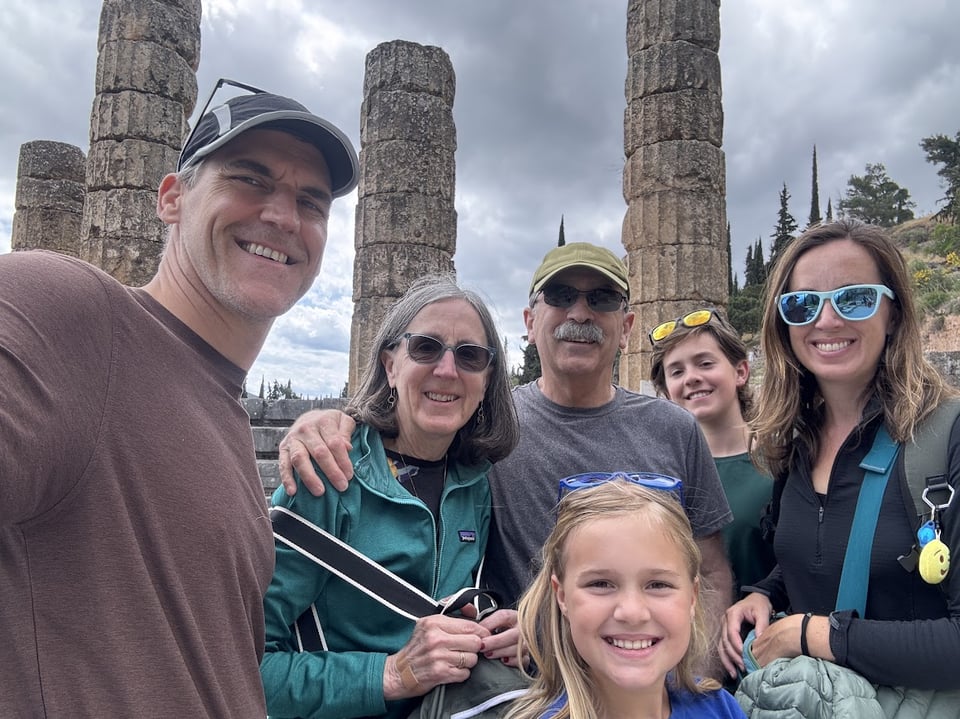
It’s with this background of what the location of Delphi would be that we set out to see it. I was honestly expecting a cave or other very basic site that ancient Greeks would visit to hear what the future might hold. I was so wrong, and glad for it. We rented a van to drive up to the site, and that was the first surprise. Delphi is nestled up in a mountainside overlooking a valley. It must have been difficult for the ancient Greeks to travel to this site, giving it even more of an air of mystery. The view was stunning and was the first surprise of the trip. Just the location alone was amazing. Coming into the area where the Oracle sat, you first are hit with how small the road is for the large number of people that are trying to visit. I can only imagine the chaos you’d be presented with during high season. After the adventure of finding parking and a quick snack, we entered the archaeological site at Delphi. I was struck by how much there was to see, as you quickly start passing through ruins of treasuries and other buildings that were erected on the path to the temple of Apollo. The Athenian treasury is surprisingly well preserved and you can see how much the various regions of Greece valued the area. In front of the treasury is a replica of the rock that the ancient Greeks believed was placed there by Zeus when he discovered the site. Just beyond that was the rock that it was believed the original Oracle sat on when giving out prophecies.
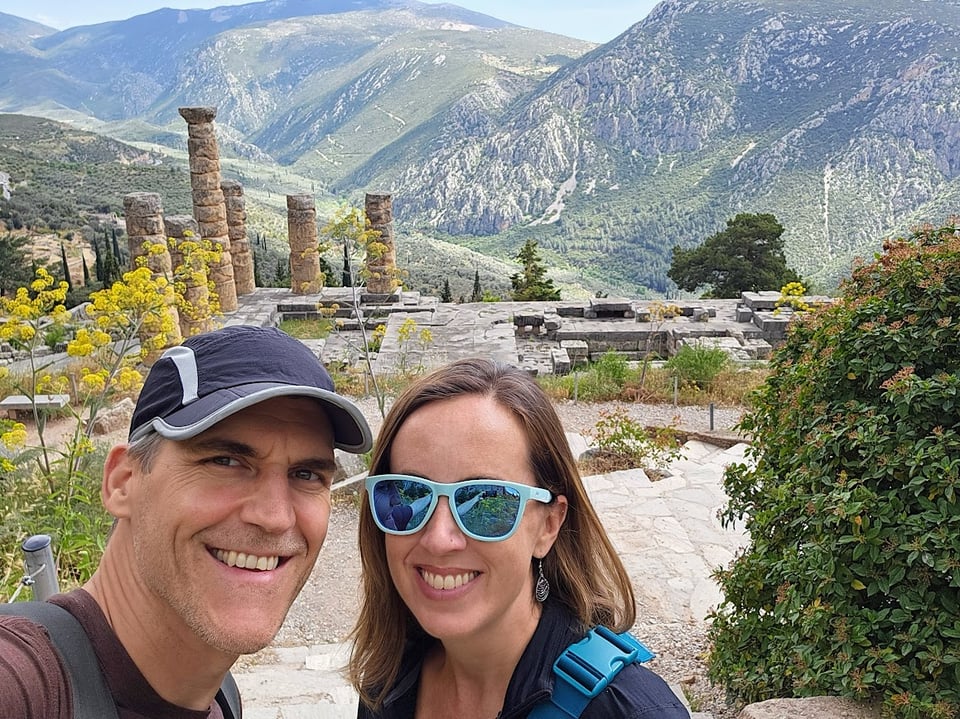
Continuing around the corner from the rock was my favorite moment of the day. There you can see the remains of various monuments built just outside of the temple, and one of them was a replica of the serpent column. The reason I was so excited was that the original serpent column was moved by Emperor Constantine to Constantinople. Many of you will know that the name of the city was later changed to Istanbul, and we saw the real serpent column while we were there! To have that connection was truly magical, drawing a line through our travels and linking two very different locations in a single moment. To the left of that monument stands the remains of the Temple of Apollo. The structure was obviously massive when it was still standing, and you can see where the Oracle’s cavern under the temple most likely was, though it is mostly covered by marble. Standing at the spot where ancient Greeks came and spoke to the Oracle felt profound. The last big surprise of the day was just up the hill from the temple. Here you find the remains of a large theater. Once the Oracle no longer was active in the spot (removed by the Romans when they conquered the region) the Greeks continued to use the area as a place where many would gather, watch plays, participate in events (there was also a stadium that was closed during our visit), and practice diplomacy. After leaving the site, we made our way through the adjacent museum and then began our journey back to Athens. We didn’t have time to explore the ruins of a temple to Athena near the site, so perhaps we’ll need to return some day!
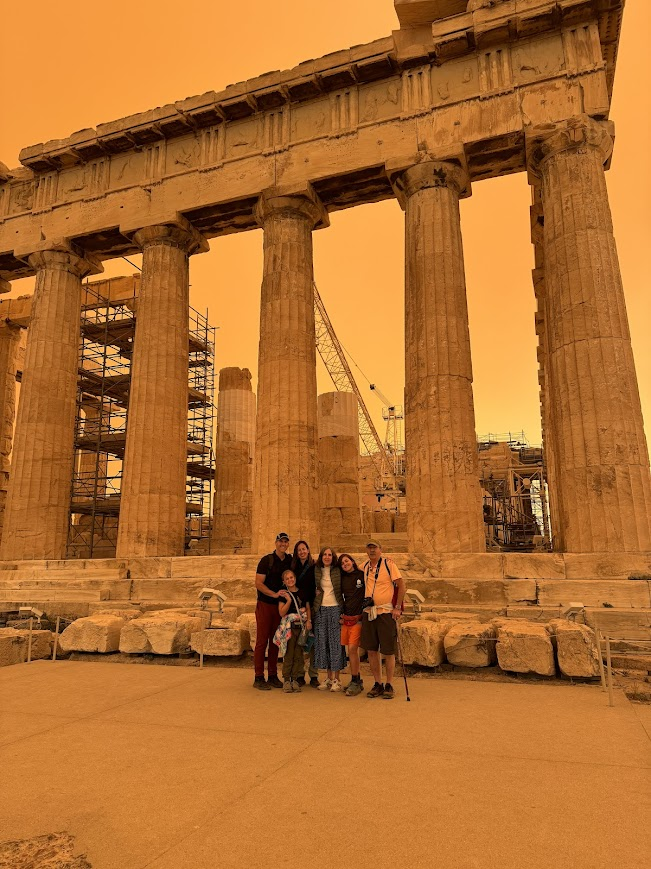
James:
🏛️ The Parthenon is quite possibly one of the most iconic structures in the world. Every part of it is meticulously sculpted to architectural perfection. Even though there are no straight lines anywhere on the structure and it’s missing all its decoration, it was amazing to see. The whole place is like a huge optical illusion! (Historians and architects are still debating on why they did this.) Its history is just as impressive - it was built to replace two previous temples that had both been destroyed, the second in 480 BCE when the Persians invaded and sacked Athens. Every piece of marble on it was hand-carved and slotted into place like a puzzle. No piece of stone is the same. It was so complicated to build that when a modern computer tried to rebuild the Parthenon digitally, it broke down!
The ancient Greeks were smart, and actually first used the Parthenon as propaganda. For example, they put statues of a mythological version of the Persian War on one side of the building so that everybody could see their glorious victory depicted in stone. And if anybody got mad, they got around it by saying, “Look, that up there is a mythological war, see? We aren’t using it to brag!” Pretty genius, right? It’s too bad that not many of the friezes survived.
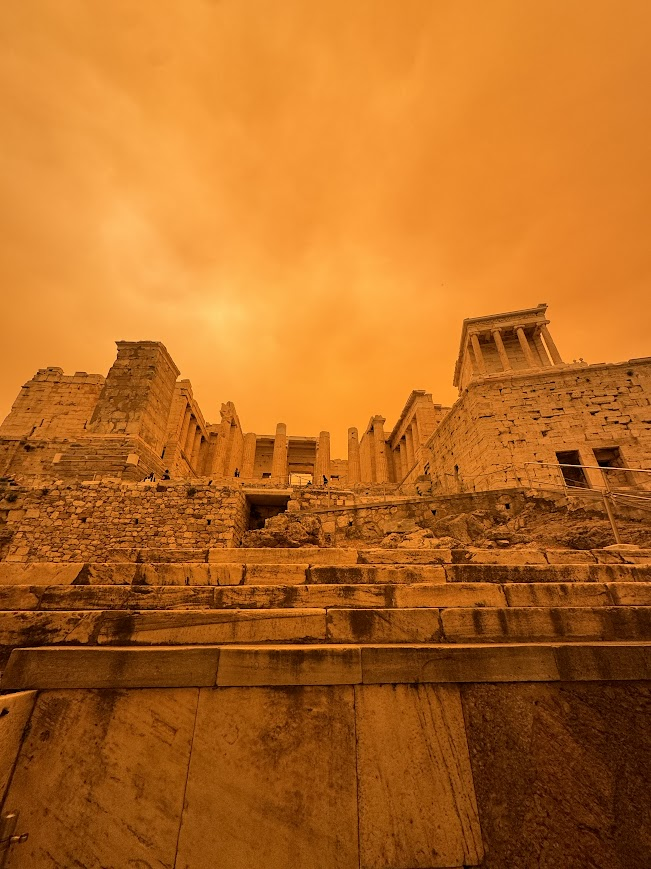
The region enjoyed a long period of relative peace afterward, with people around the world visiting the Parthenon and reinforcing its role as propaganda by telling everyone they knew how much of a wonder the structure was. But peace can’t last forever - in the 6th century CE, the Romans turned the Parthenon into a Christian church after conquering the city, and it stayed that way for over a millennium. The city was finally torn from the Romans’ grasp in 1457 when the Ottoman Empire laid siege to and captured it. They went straight to work on the Parthenon, changing it into a mosque. Everything Christian was stripped away and the inside was given a full makeover. The Ottomans were quite happy using it!
However, history wasn’t done with Athens just yet. During the Morean War, in a conflict between the Ottomans and the Venetians that lasted from 1684-1699, the Venetians climbed onto the Hill of Philopappos, a hill close to the Acropolis, and began firing mortar rounds. The Ottomans had been using the Parthenon as a munitions dump, because they believed the Venetians wanted to preserve the ancient buildings. They very quickly discovered how wrong they were! The resulting explosion leveled the roof and friezes, along with some huge chunks of pillar. Restoration attempts are still continuing to this day, but it will take many more years. The remains are what you can see today.
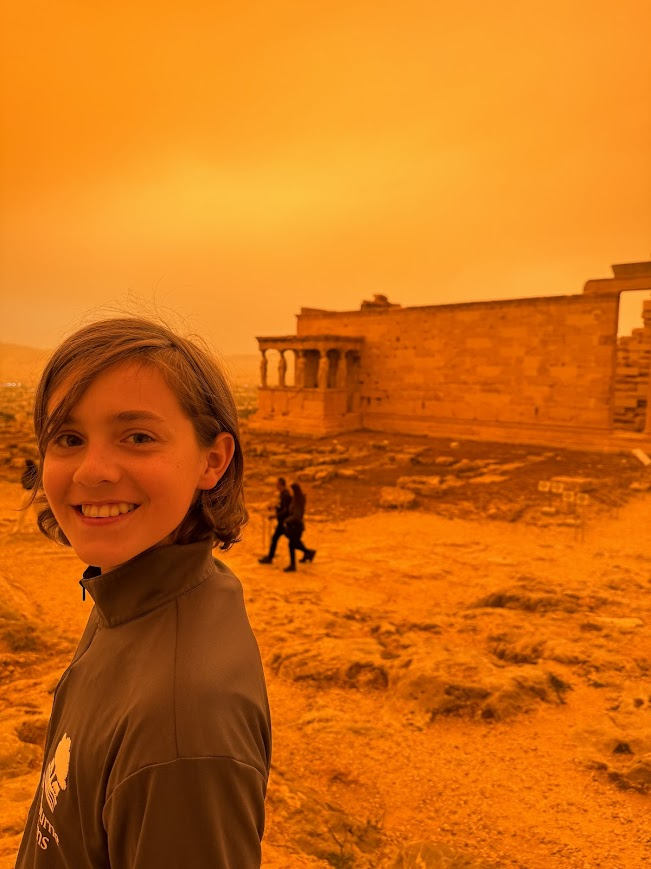
The Parthenon is nothing less than extraordinary. As we walked through the Acropolis, I was blown away by all of the wonders it contained. It also helped that when we visited, sand from the Sahara Desert had invaded the Athens sky. At sunset, it turned the sky a brilliant orange. That provided a wonderful backdrop for photos! The color also mixed well with the soothing tan of the Parthenon. This will definitely take one of the top spots in “Most Memorable Visits!”
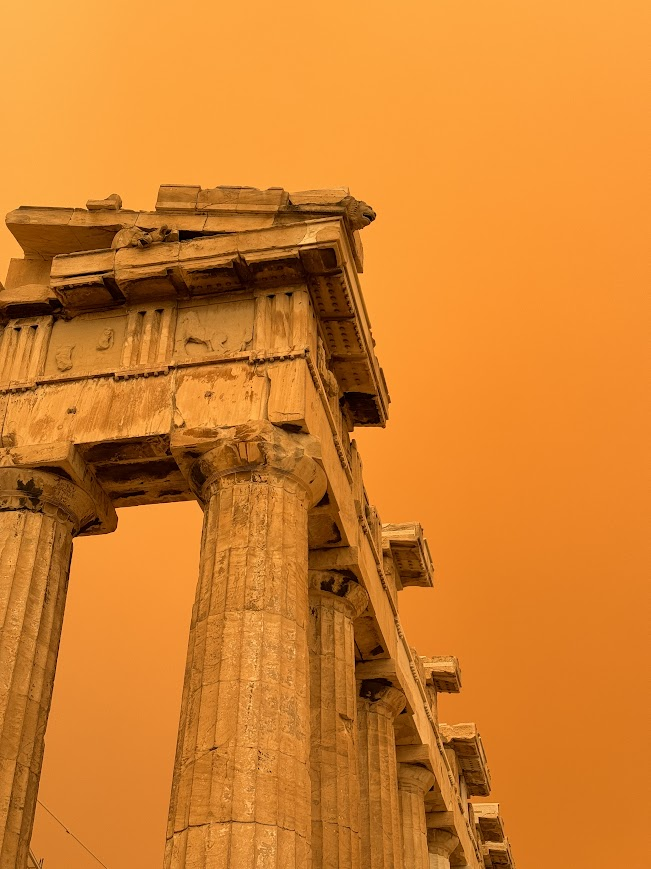
*Special guest note from Jim/Papi:
I have wanted to visit the Acropolis and see the Parthenon for my entire adult life, and probably for some time before that. Early on, because I was an aspiring architect, visiting the Parthenon felt almost obligatory. The story of Le Corbusier spending days on the Acropolis sketching from all conceivable perspectives is part of architectural legend (known primarily to architecture geeks), so the site loomed large in my mind. But even after realizing that I had no business trying to practice architecture (lack of talent being the primary impediment), I still harbored a love of architecture and a desire to see its iconic places. As Liz and I wandered around the Athens neighborhood near our AirBNB (while we waited for Caitlin, Sean, James, and Abby), I caught my first glimpse of the Acropolis. Not a postcard, not a picture in a book or a slide in Art History 101, but the real thing! I was taken aback by how emotional I became. So to climb the 500+ feet to the top and stand just yards away from all the buildings was incredible. It was a truly moving experience for me.
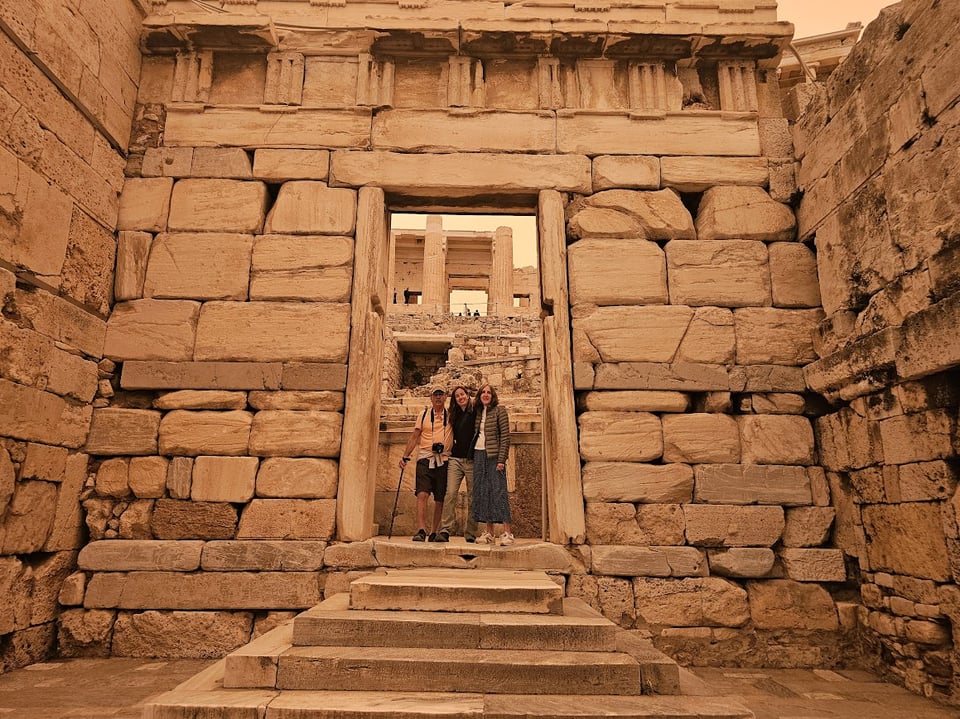
Abby:
One of our favorite parts of this trip has been the food. It’s really fun to try all the new dishes and see the varieties in every place we visit. This week I will be listing some of the best yums that we have had over the months.
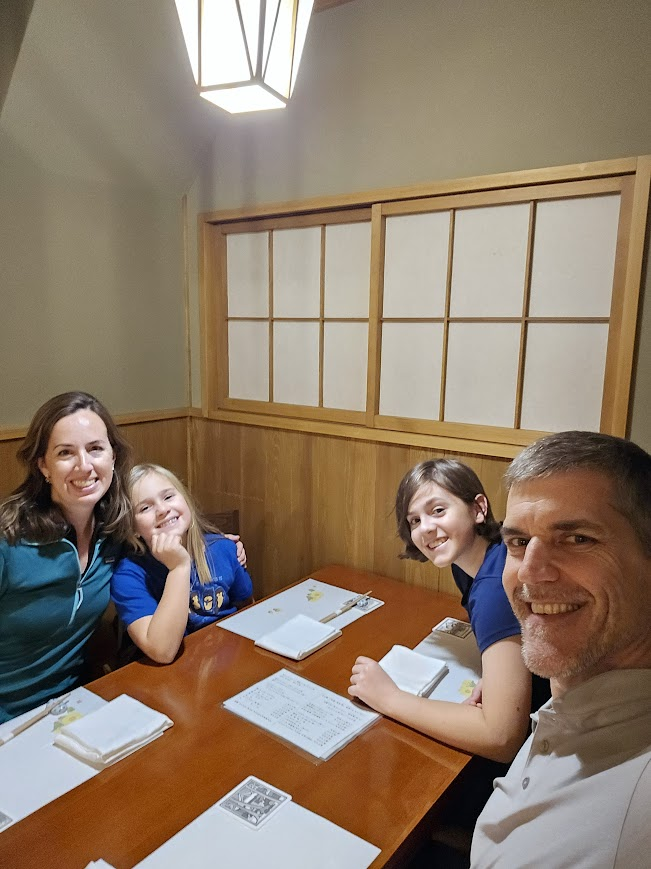
In Japan, we all loved the ramen in Hiroshima. The meat flavored the broth so that it had a bit of a meaty tinge to it. It was very fresh and very delicious. Another one is the Kaiseki we had for Mom’s birthday. Kaiseki is a traditional Japanese meal. It has multiple courses, and you don’t order from a menu. Whatever they decide to make that day is what you get - which, I think, is the best part! We had some very delicious, unique food for our courses. There was salad, there was fish, there was ice cream (for Mom’s birthday)! Japan definitely had some of the best food.
New Zealand and Australia had mostly familiar food, but our favorite was the delicious pies that were made fresh every day. They might have pork, ground beef, lamb, or even chicken curry. They were a really nice snack to bring on hikes.
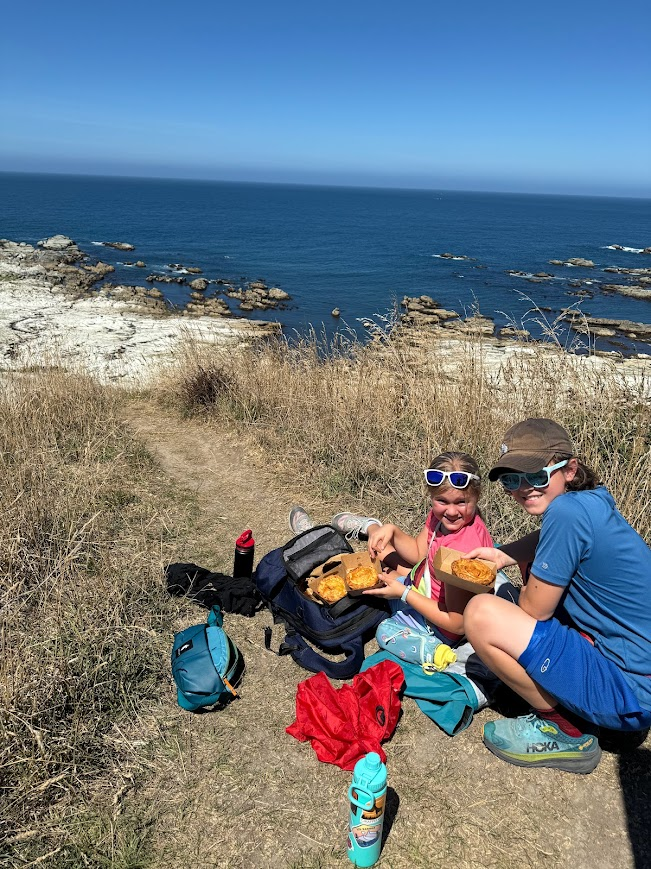
Another one of our faves is the food we had in Thailand. We love to have Thai food even at home, so we were very excited to go to Thailand and have the real authentic dishes. We enjoyed stuffing ourselves with pad thai, pad see ew, satay, fried rice, and, probably most of all, mango and sticky rice. All I can say is: it was delicious.
In Istanbul, we loved the moussaka, the baklava, and we really liked the dried apricots and turkish delight. The Turkish ice cream was also really fun because when you order they also serve you a little performance! Look it up to see what I mean - it’s quite fun to watch.
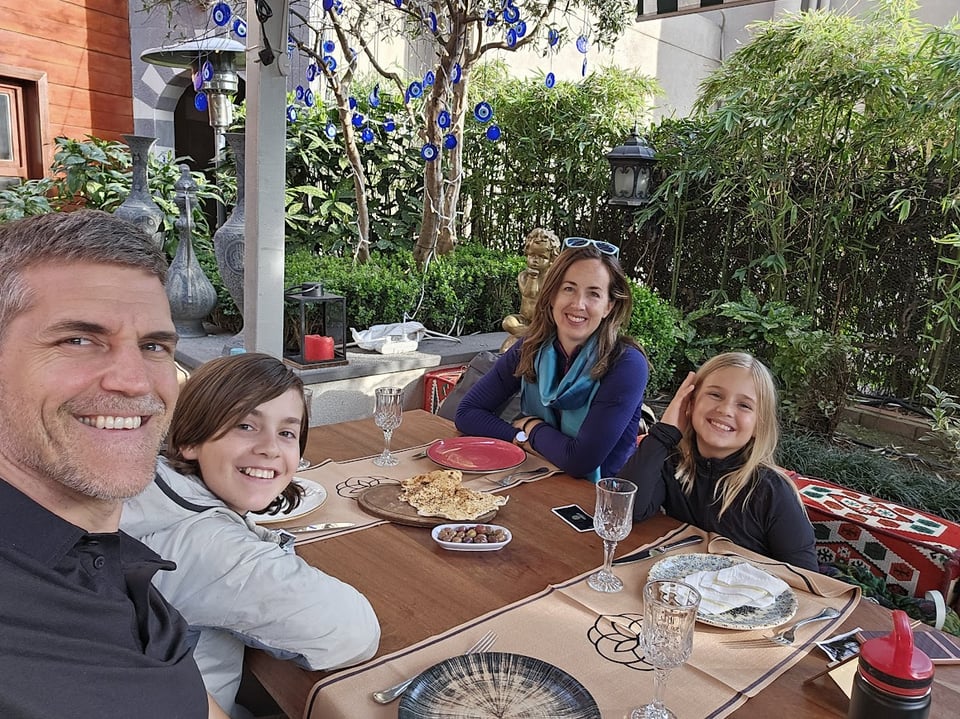
Greek food is one of my favorite types of food, so I was pumped to come snarf down some gyros in Greece. ( It’s pronounced Yer-oes. I knew that, but most of our tour guides made sure to tell us - so JIC.) And snarf them down I did. Meems, my grandmother, says that I have probably eaten at least one every day here. Souvlaki is another good one. It’s basically a gyro but with chunks of meat instead of shavings. For anybody who (sadly) has never heard of a gyro, let me tell you. It’s very thin cut meat, usually pork, with onions, fries, tomatoes, and tzatziki sauce all in a freshly baked pita wrap. It’s veeery good! All of us are enjoying the Greek food, even the non-gyros.
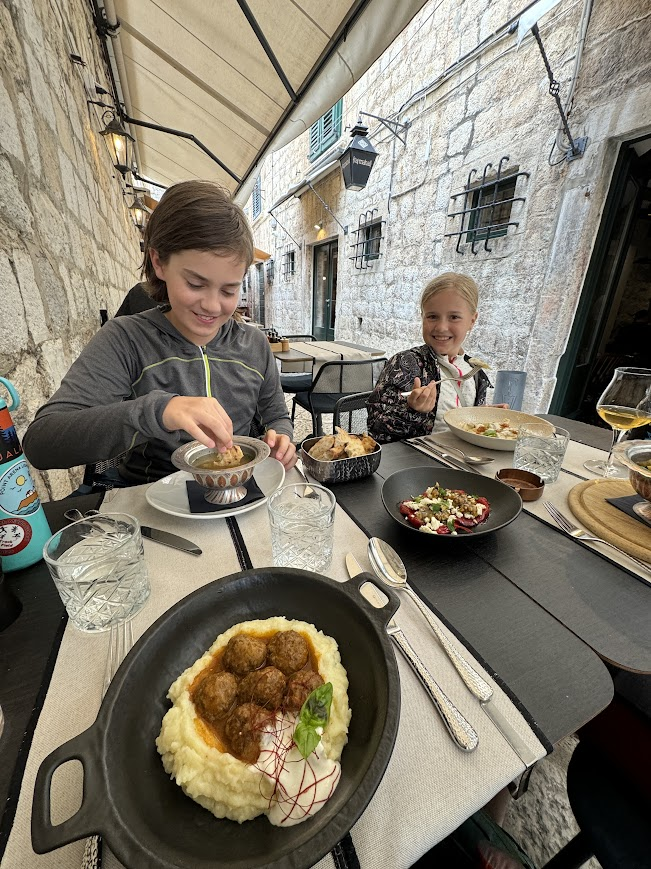
Oh, and I cannot forget the gelato! No, not ice cream. Ge-lat-o. There is a difference. (I’m very serious about this stuff.) For starters, gelato is better. The gelato in Europe is amazing. The best part is, you can have it any day; there is always a gelato shop right around the corner. If you eat ice cream in the US while it’s raining, people will give you that odd why-are-you-wasting-your-money-on-something-cold-when-it's-literally-raining look. If you eat gelato when it’s raining in Europe, people probably won’t even notice because they’re eating gelato too. We had delicious gelato pretty much every day in Croatia. Even in the rain!
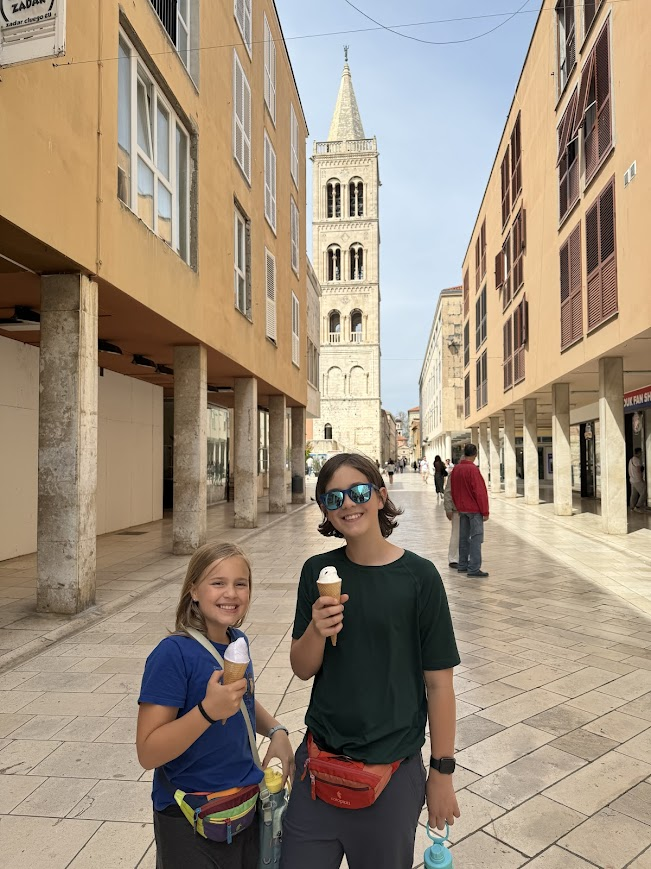
Food isn’t just yummy. It’s part of the culture, the roots of the place that you’re in. In my opinion, you can’t fully enjoy a place without trying the best of its food! Next week, we’re off to Italy, the home of my absolute favorite type of food! Ciao! 😊
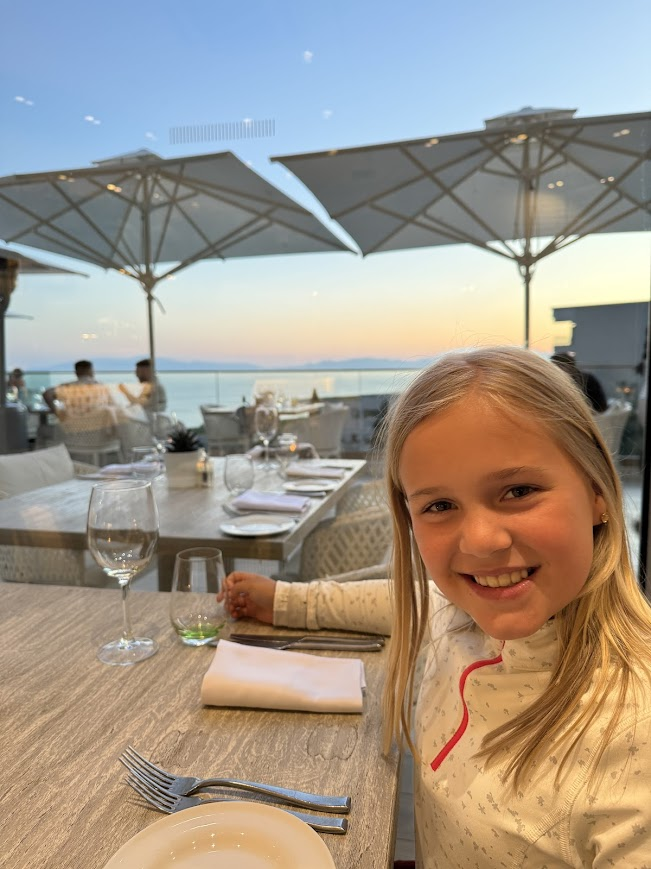
See you next week!
Sean, Caitlin, James, and Abby
Catching up? Read week 1, 2, 3, 4, 5, 6, 7, 8, 9, 10, 11, 12, 13, 14, or 15.
